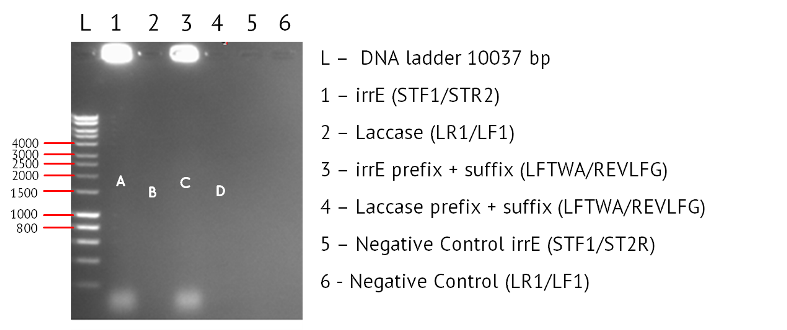Team:University College London/LabBook/Week10
From 2012.igem.org



Tuesday 14.8.12
Aim - Repeat experiment 9.2: We think there might have been a confusion in preparing the samples for the PCR because we did not obtain any bands on the gel for irrE or Laccase.
Method
Step 1 - Setting up PCR tubes: Thaw reagents and add to PCR tubes in the proportions described in the table below
| PCR Components | Volume (ul) |
|---|---|
| 5x Reaction Buffer | 10 |
| 25mM MgCl2 | 4 |
| 10mM dNTPs | 1 |
| 10uM Forward primer | 5 |
| 10uM Reverse primer | 5 |
| DNA Polymerase | 0.25 |
| Nuclease Free Water | 24.25 |
| Template DNA | 0.5 |
| Total Volume | 0.5 |
Step 2 - PCR program: Add PCR tubes to a thermocycler and run under the following conditions.
| PCR conditions | Temp (oC) | Time (s) |
|---|---|---|
| Initial Denaturation (1 cycle) | 95 | 30 |
| Denaturation/Annealing/Extension (30 cycles) | 95/55/72 | 10/25/120 |
| Final Extension (1 cycle) | 72 | 600 |
| Hold | 4 | ∞ |
Step 1 - Setting up PCR tubes: The table below gives the identity of the primers used for each reaction. It indicates the samples that were set up for the repeat of Expt 9.2, as was done in the first attempt of Expt 9.2.
| DNA Template | Function | Module | Primer Pair | Primer | Primer Sequence |
|---|---|---|---|---|---|
| BBa_K729002 | Laccase Gene | Degradation | LR1/LF1 | LR1 | gaatacggtctttttataccg |
| LF1 | gaaataactatgcaacgtcg | ||||
| REVLF2/LFTW0 | REVLF2 | gtttcttcctgcagcggccgctactagtagaatacggtctttttataccg | |||
| LFTW0 | gtttcttcgaattcgcggccgcttctagaggaaataactatgcaacgtcg | ||||
| BBa_K729001 | irrE | Salt Tolerance | STF1/ST2R | STF1 | atggggccaaaagctaaagctgaagcc |
| ST2R | tcactgtgcagcgtcctgcg | ||||
| STF3/ST4R | STF3 | gtttcttcgaattcgcggccgcttctagagatggggccaaaagctaaagctgaagcc | |||
| ST4R | gtttcttcctgcagcggccgctactagtatcactgtgcagcgtcctgcg |
| Template DNA | Primer Pair |
|---|---|
| None (Negative Control) | STF1/ST2R |
| None (Negative Control) | LR1/LF1 |
| None (Negative Control) | BirAF/BirAR |
Results: The image below shows a 1% Agarose Gel of an Analytical Restriction Enzyme Digest for Expt 9.2, with a 1000bp ladder. Again we have not obtained any bands. The strong patches of white demonstrate to us that our DNA template is at a high concentration, and should be diluted before we attempt any repeats. The lack of any products suggest we need to reconsider the protocol. Revising the annealing temperature or designing new primers will have to be considered,


9-4
 " />
" /></html>
10-1
 "
"